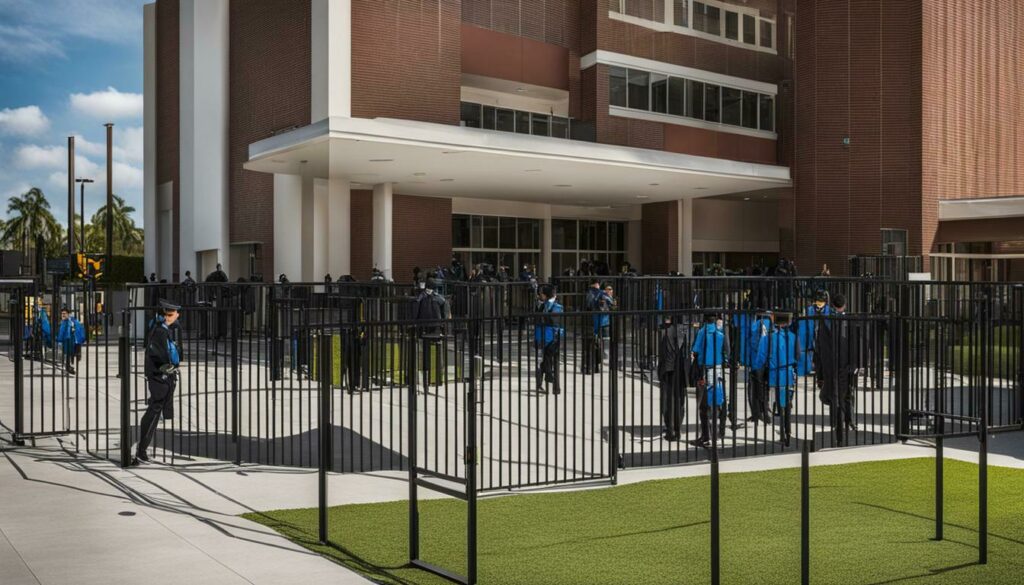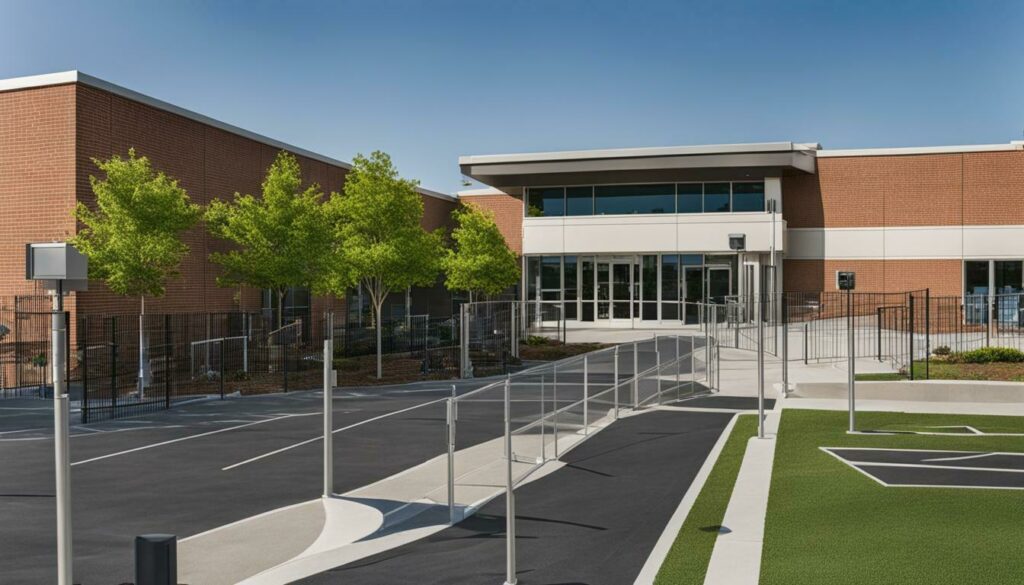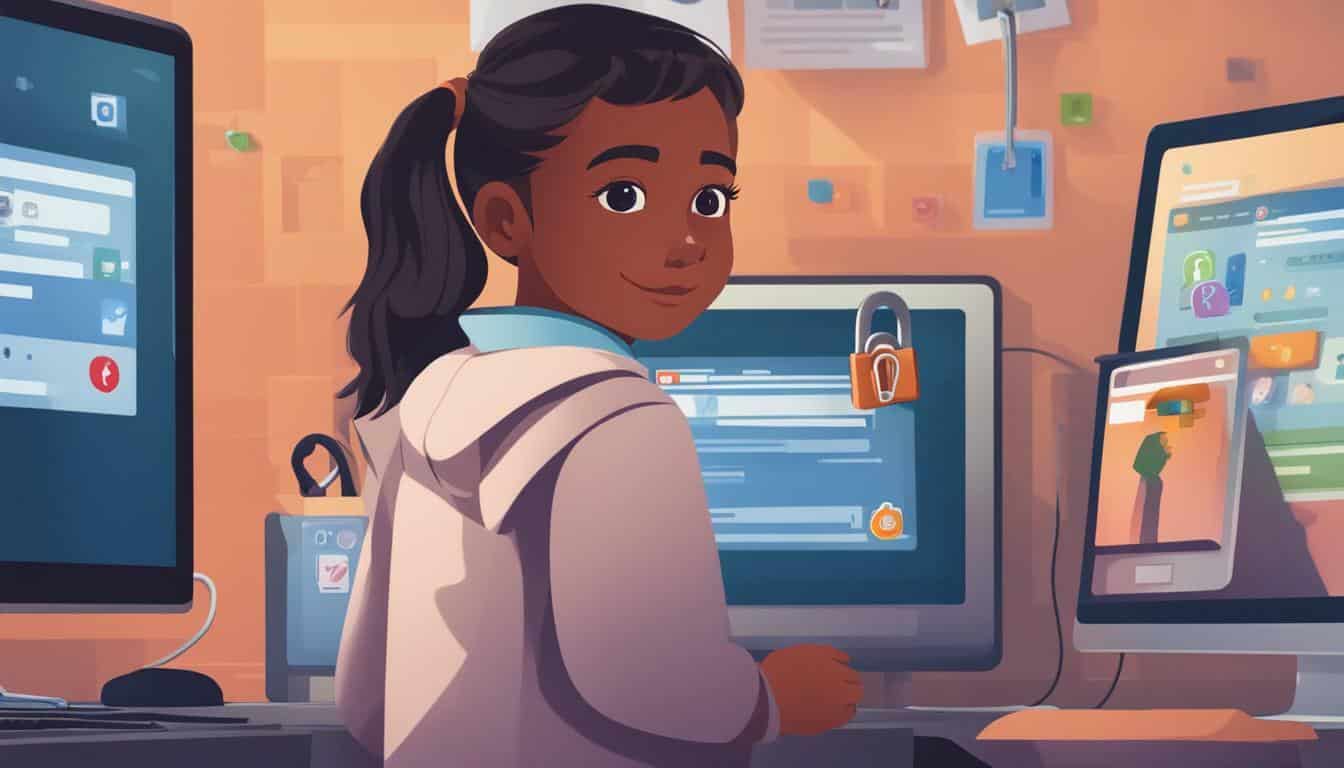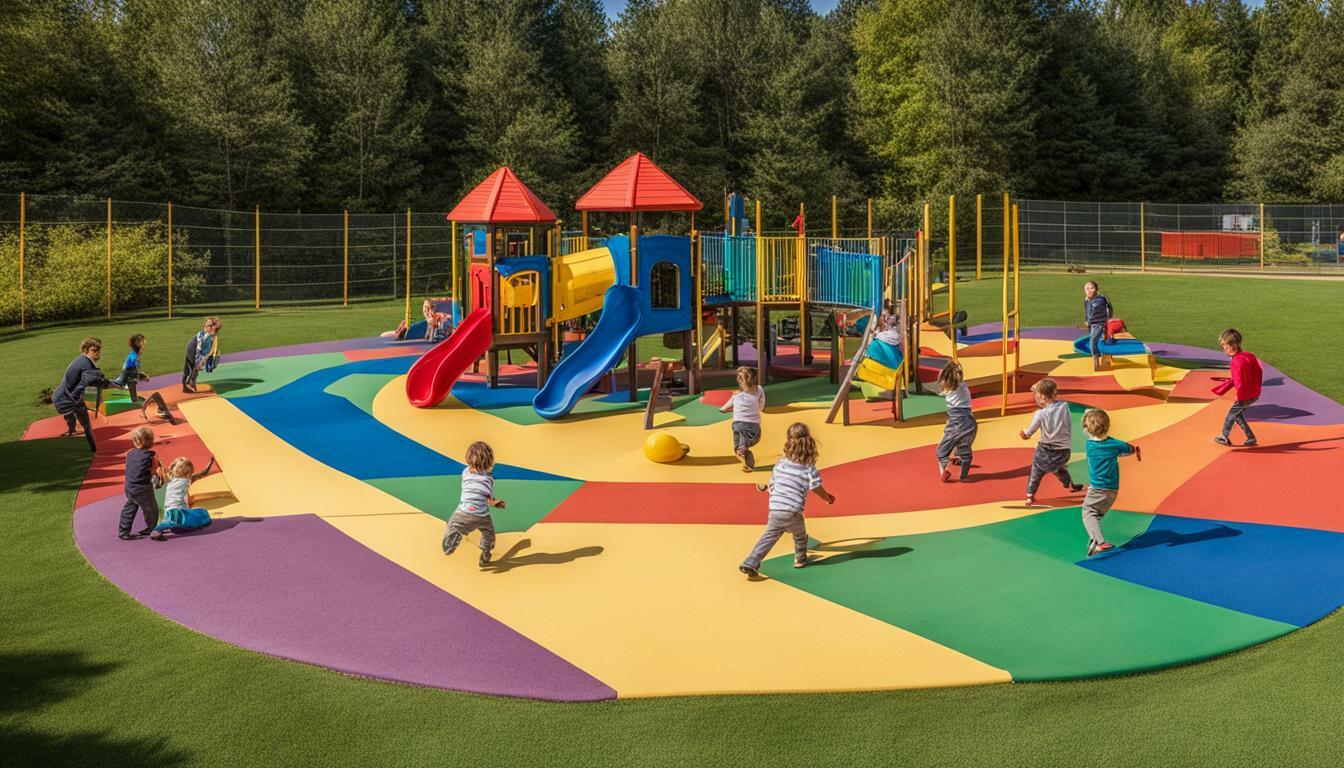School safety is a top priority for parents and educators alike. By following these tips, you can help ensure your child’s well-being on campus.
When it comes to school safety, there are several key factors to consider. From personal safety to emergency preparedness and creating a secure learning environment, every aspect plays a vital role in keeping our students safe.
Key Takeaways:
- Plan a safe route to and from school.
- Walk in groups and avoid potentially dangerous areas.
- Establish clear rules for play to prevent accidents.
- Recognize and report suspicious behavior promptly.
- Teach anger management and promote respect for others.
Implementing these tips will contribute to a safe learning environment where students can thrive academically and emotionally. Stay tuned for more essential advice on school safety in the upcoming sections of this article.
Establishing Safe Routes and Rules for Play
Creating a safe journey to and from school is crucial for your child’s overall safety. By planning a safe route and establishing clear rules for play, you can help protect your child from potential dangers and ensure they have a secure learning environment. Here are some key tips to consider:
- Encourage walking in groups: Walking to school with friends or in a group can enhance safety and deter potential threats. Teach your child the importance of sticking together and avoiding isolated areas.
- Avoid potentially dangerous areas: Familiarize yourself and your child with the surroundings and identify any areas that may pose a risk. Discuss these areas and instruct your child to avoid them while going to and from school.
- Teach road safety: Ensure your child understands the importance of obeying traffic rules when crossing streets. Emphasize the significance of using designated crosswalks, looking both ways before crossing, and waiting for the signal to turn green.
- Practice personal safety: Teach your child to secure their personal belongings and be cautious of strangers. Encourage them to keep their bags zipped and close to their bodies, and to never share personal information with anyone they don’t know.
According to child protection experts, establishing clear rules for play is essential for maintaining a safe learning environment. Here are some guidelines to consider:
- Set boundaries: Discuss with your child the specific areas where they are allowed to play and establish boundaries. Ensure they understand the importance of staying within these boundaries and not wandering off to unfamiliar or potentially unsafe places.
- Teach conflict resolution: Encourage your child to resolve conflicts peacefully and avoid physical altercations. Teach them techniques for effective communication and problem-solving, helping them to handle disagreements in a non-violent manner.
By following these tips and establishing safe routes and rules for play, you can play an active role in ensuring your child’s safety at school. Remember, open communication with your child is crucial, so regularly discuss safety concerns and encourage them to report any suspicious behavior to a trusted adult.
| Benefits of Safe Routes and Rules for Play: | Key Tips: |
|---|---|
| Enhanced student safety | Encourage walking in groups |
| Prevention of potential dangers | Avoid potentially dangerous areas |
| Road safety awareness | Teach road safety |
| Protection of personal belongings | Practice personal safety |
| Promoting a safe learning environment | Set boundaries and teach conflict resolution |
Recognizing and Reporting Suspicious Behavior
Being able to recognize and report suspicious behavior is essential for maintaining a safe school environment. By staying alert and proactive, you can help prevent potential threats and ensure the well-being of students and staff.
Here are some tips for identifying and reporting suspicious behavior:
- Pay attention to unusual or out-of-place individuals on school grounds. Look for anyone who seems to be loitering or behaving in a suspicious manner.
- Take note of individuals who are overly interested in security measures or emergency protocols. This could indicate a potential threat or someone trying to gather information.
- If you see something, say something. Trust your instincts and report any concerns to a teacher, principal, or school security officer. Provide detailed information about the person or incident, including physical appearance and any observed actions.
- Encourage your child to communicate any suspicious behavior they witness or hear about from their peers. Teach them the importance of reporting concerns to a trusted adult.
To ensure a safe learning environment, it is crucial that all members of the school community work together to recognize and report suspicious behavior promptly. By doing so, we can help prevent potential incidents and promote a secure atmosphere for everyone.
Quote:
“Safety and security don’t just happen, they are the result of collective consensus and public investment. We owe our children, the most vulnerable citizens in our society, a life free of violence and fear.” – Nelson Mandela
Summary:
Recognizing and reporting suspicious behavior is essential for maintaining school security. By staying vigilant, communicating concerns, and working together, we can create a safe and secure learning environment for all students and staff.
Table:
| Warning Signs of Suspicious Behavior | Actions to Take |
|---|---|
| Unusual interest in security measures | Inform school authorities and provide detailed information |
| Loitering or behaving in a suspicious manner | Report concerns to a teacher, principal, or school security officer |
| Overheard conversations about potential threats | Encourage children to communicate concerns to a trusted adult |

Promoting healthy emotional management and respectful behavior is crucial in preventing violence and creating a safe learning environment. By equipping students with effective anger management techniques, we empower them to handle their emotions in a positive and non-violent way. Additionally, teaching children the value of respecting others and their belongings fosters a sense of empathy and reduces the likelihood of conflicts.
One way to teach anger management is by encouraging open communication and providing a safe space for students to express their feelings. By listening actively and validating their emotions, we help them develop the necessary skills to identify and manage anger triggers. It is important to emphasize that feeling angry is natural, but how we choose to respond is what makes a difference. Role-playing scenarios and using real-life examples can also help students understand the consequences of their actions and learn to make better choices.
Respecting others extends beyond treating individuals with kindness and empathy. It also involves respecting personal boundaries, belongings, and differences among classmates. By teaching the importance of respecting personal space and the property of others, we cultivate a culture of mutual respect and understanding. Involving students in activities that promote teamwork and collaboration can further strengthen these values.
To summarize, teaching anger management and fostering respect in schools are vital to preventing violence and creating a safe learning environment. By equipping students with the necessary tools to manage their emotions and emphasizing the importance of respecting others, we can contribute to a positive and harmonious educational experience for all.

| Key Points: |
|---|
| 1. Promote healthy emotional management |
| 2. Teach effective anger management techniques |
| 3. Encourage open communication |
| 4. Provide a safe space for expression |
| 5. Emphasize the importance of respect |
| 6. Teach personal boundaries and empathy |
| 7. Involve students in teamwork activities |
Understanding School Safety Measures and Protocols
Familiarizing yourself with the school’s safety measures and protocols is essential in ensuring a secure environment for your child. Schools have a responsibility to implement various measures to protect students and staff, ranging from emergency procedures to cybersecurity practices. By understanding these protocols, you can actively contribute to creating a safe learning environment.
One of the key safety measures is the implementation of school lockdown procedures. In case of an emergency situation, such as an active shooter or threat within the vicinity, schools have specific procedures to protect students and staff. These procedures often involve locking doors, closing blinds, and maintaining silence. It is crucial for students and teachers to familiarize themselves with these protocols and practice them regularly through drills.
Furthermore, schools prioritize campus safety by implementing security measures such as surveillance systems, visitor policies, and restricted access to certain areas. These measures help deter potential threats and ensure that the school remains a safe space for everyone. It is important to support and comply with these security protocols to maintain the overall safety of the school community.

Cybersecurity is another crucial aspect of ensuring a safe learning environment. Schools collect and store substantial amounts of sensitive student and staff data, making them potential targets for cyber attacks. To combat this, schools have established protocols to safeguard personal information and prevent unauthorized access. As parents, it is essential to educate your child about online safety, including the importance of strong passwords, avoiding suspicious emails or websites, and reporting any suspicious online activity.
In summary, understanding and supporting school safety measures and protocols is vital for creating a secure environment for your child. By familiarizing yourself with lockdown procedures, complying with security measures, promoting cybersecurity practices, and educating your child about online safety, you contribute to the overall safety and well-being of the school community.
Building Strong Relationships and Communication
Establishing strong relationships and open lines of communication can contribute to a safe and supportive school environment for all. When parents, teachers, and students work together, it creates a sense of community and fosters a culture of respect and understanding. By actively engaging in open dialogue, concerns can be addressed promptly, and potential issues can be identified and resolved before they escalate.
Bullying prevention is an essential aspect of maintaining a safe learning environment. By getting to know your child’s friends and their parents, you can have a better understanding of their social interactions and intervene if necessary. Encourage your child to be open about their experiences at school and listen attentively. By fostering open communication, you can support your child in dealing with any bullying incidents effectively.
Additionally, teaching children personal information and emergency procedures is crucial. Ensure they know their full name, address, and contact information, as well as how to reach you or another trusted adult in case of an emergency. Encourage them to arrive early at bus stops, standing away from the curb, and to obey traffic rules when crossing streets. Emphasize the importance of using seat belts in cars and wearing helmets when biking. Teach them to walk only at intersections with crossing guards and to secure their personal belongings.
Moreover, staying informed about safety protocols, cybersecurity practices, and anti-bullying policies is essential. By understanding these measures, you can actively participate in your child’s safety and advocate for improvements when necessary. Regularly communicate with your child’s school to ensure these policies are effectively implemented, creating a secure learning environment for all students.
FAQ
Q: What tips can help students stay safe at school?
A: Some tips for staying safe at school include planning a safe route to and from school, walking in groups, establishing clear rules for play, reporting suspicious behavior, managing anger effectively, respecting others and their belongings, looking for warning signs of a troubled child, ensuring school safety measures are in place, getting to know your child’s friends and their parents, teaching children personal information and emergency procedures, arriving early and standing away from the curb at bus stops, obeying traffic rules when crossing streets, wearing seat belts in cars, using helmets and riding on the right side of the road when biking, walking only at intersections with crossing guards, fostering open communication with parents and guardians, and securing personal belongings.
Q: What should parents and students know about personal safety at school?
A: Parents and students should be aware of personal safety measures such as planning a safe route to and from school, walking in groups, and reporting any suspicious behavior. It’s also important to manage anger effectively, respect others and their belongings, and look for warning signs of a troubled child. Teaching children personal information and emergency procedures is essential, as well as fostering open communication with parents and guardians.
Q: How can parents ensure their child’s safety at school?
A: Parents can ensure their child’s safety at school by getting to know their child’s friends and their parents, ensuring school safety measures are in place, and teaching children personal information and emergency procedures. It’s also important to foster open communication with parents and guardians and to secure personal belongings.
Q: What should students be mindful of when traveling to and from school?
A: Students should be mindful of arriving early and standing away from the curb at bus stops, obeying traffic rules when crossing streets, wearing seat belts in cars, using helmets and riding on the right side of the road when biking, and walking only at intersections with crossing guards. These precautions can help ensure their safety while traveling to and from school.
Q: How can parents and schools work together to create a safe learning environment?
A: Parents and schools can work together to create a safe learning environment by building strong relationships and open communication. It’s important for parents to get to know their child’s teachers and to address any concerns or issues promptly. Schools should also have safety measures and protocols in place, such as lockdown procedures and emergency drills, and security personnel to ensure student safety.
Q: What can parents do to prevent bullying at school?
A: Parents can prevent bullying at school by teaching their children about kindness, empathy, and respect for others. They should also encourage open communication with their child about any bullying experiences and address the issue promptly. Building strong relationships with teachers and school officials can also help in addressing and preventing bullying incidents.









